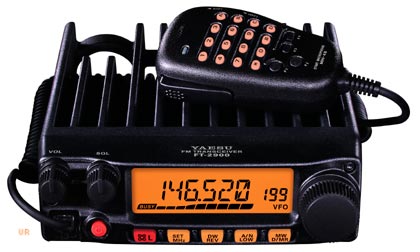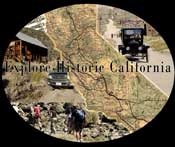|
Back
in the days when Explore Historic California ran
commercial four wheel drive (4WD) tours, we required all
the vehicles in our group to have CB radios. The radios
provided an easy and relatively inexpensive way to
communicate from vehicle to vehicle while on the move.
Our clients also learned that radio communication helped
enhance the enjoyment and safety of backcountry travel.
 |
|
Bill Halstead's Jeep was equipped with only
a CB radio while Marty Cole, KB6OME, had
both CB and amateur radio equipment in his
Tacoma. |
While
we no longer guide commercial tours, we still use two
way radios when traveling in the backcountry. Which
radios we use depends on where we are going and who we
are with. Many of our personal traveling companions are
also amateur radio (ham) operators, so most of the time
we use VHF amateur radio which offers greater range,
better clarity and less interference than CB radio. We
still use CB radio when traveling with non-hams as well
as when traveling with other groups or clubs.
Regardless of the radio or radio service, there is some
yearly maintenance that should be performed to keep
communications equipment in good working order.
 |
|
A basic CB radio such as this Uniden, can
provide reliable vehicle to vehicle
backcountry communication. |
Your
radio’s antenna is the link to the outside world. A
poorly functioning antenna will reduce radio range and
could possibly cause damage to the radio. Check for
corrosion (and clean as necessary) around the antenna
base where it connects to the antenna mount. An old
toothbrush and pencil eraser work well to remove minor
corrosion. More serious corrosion can be removed by the
gentle use of a soft wire (brass) brush or Scotch
Brite abrasive pad. Avoid harsh abrasives. After
cleaning, the antenna base can be lubricated with liquid
silicone to make it easier to remove. If your antenna
uses locking screws to hold secure it to a loading coil
or spring, make sure these are all present and secure as
well.
The
antenna is linked to the radio by way of a coaxial
cable. The portions of the cable outside the vehicle are
subject to detonation from long (years) exposure to
sunlight. The black plastic jacket dries out and cracks
which will cause the cable to corrode on the inside and
work less efficiently. The cable usually connects to the
antenna mount through a soldered and sealed connection.
This is also subject to corrosion from water trapped
inside, but may be difficult to inspect. Corroded
connections should be repaired. Since coaxial cable
can’t be spliced like ordinary electrical wire,
detonated antenna cable should be replaced. Usually it’s
easier and more cost efficient to replace the entire
cable and antenna mount.
Inside
the vehicle, the antenna cable connects to the radio
with a special screw on connector. Check this connector
at the radio to make sure it is tight and the cable
isn’t damaged or pinched. Also check the back of the
radio to make sure the power cables are in good
condition and properly plugged in (although not all
radios have a plug at the radio end of the power cable).
The
(usually) red and black wires on the back of the radio
connect it to the vehicle’s electrical system. The red
wire is 12v positive and the black wire is
negative. CB radios draw about 2 amperes of current
when transmitting, but higher powered amateur radios can
draw 10 times as much current. Check the connections
where your radio power wires tie into the vehicle
electrical system to make sure the connections are free
of corrosion, are properly insulted, and are secure.
 |
|
Mobile amateur radios are approximately the same
size as many CB's, but offer better voice
clarity, higher power and more channel options.
However, an operator license is reqired. |
Inspect your radio’s coiled microphone cable for signs
of wear. Sunlight will eventually damage the plastic
outer insulation making it brittle and subject to
cracking. Some microphones have cables that can be
easily unplugged from inside the microphone housing for
replacement. Others have to be unsoldered for removal
and the new cable then has to be resoldered when
installed. If you don’t have the soldering skills or
equipment, replacing the entire microphone may be less
contentious than taking it in for repair. At the
opposite end of the mic cable is a connector at the
radio. Check that the connector is properly seated and
tight and the cable hasn’t deteriorated from bending
near the connector.
 |
|
Family Radio Service (FRS) handhelds are
compact and easy to use, but don't work well
from vehicle to vehicle. |
Handheld radios are a bit easier to maintain than mobile
radios. Check the battery contacts to make sure they
aren’t corroded. You did remove the batteries when you
put the radio away last season, didn’t you? Lightly
corroded contacts can be cleaned with an old toothbrush
and pencil eraser. If corrosion is extensive, the radio
may be damaged beyond economic repair. Also check your
batteries or battery packs and be sure to fully charge
rechargeable batteries. Not all handheld radios have
removable antennas. FRS/GMRS radios do not, MURS radios
may, and most amateur radios do have removable antennas.
Inspect the antenna connection to make sure it is free
of corrosion and seats tightly. The antenna should also
be free from damage. We have to be vigilant with our
handhelds’ antennas because the dog and cats enjoy
chewing on the antenna tips.
Amateur, CB, FRS/GMRS and MURS radios are well suited to
backcountry and emergency communication because they can
operate without connection to network infrastructure.
Cell phones, on the other hand, must be connected to the
cellular network to provide communications although some
apps, such as GPS and compass, may have limited
functionality without connectivity.
Cellular networks are well established in urban and
suburban settings, but offer sparse coverage in the
backcountry. Cellular coverage is also affected by
regional topography such as mountains, canyons and dense
vegetation blocking the cellular radio signals.
One
way of enhancing cell coverage in poor signal areas is
through the use of a cellular booster. Some older cell
phones had tiny external antenna connectors, but modern
3G/4G devices only have complex internal antennas. These
can be connected to a booster through a coupling cradle.
Boosters cost several hundred dollars (and up) and offer
limited effectiveness.
|
